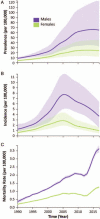Human immunodeficiency virus/acquired immunodeficiency syndrome prevalence, incidence, and mortality in China, 1990 to 2017: a secondary analysis of the Global Burden of Disease Study 2017 data
- PMID: 33883410
- PMCID: PMC8143770
- DOI: 10.1097/CM9.0000000000001447
Human immunodeficiency virus/acquired immunodeficiency syndrome prevalence, incidence, and mortality in China, 1990 to 2017: a secondary analysis of the Global Burden of Disease Study 2017 data
Abstract
Background: Despite almost two decades of well-funded and comprehensive response efforts by the Chinese Government, human immunodeficiency virus/acquired immunodeficiency syndrome (HIV/AIDS) remains a major problem in China. Yet, few studies have recently examined long-term trends in HIV/AIDS prevalence, incidence, and mortality at the national level. This study aimed to determine the prevalence, incidence, and mortality trends for HIV/AIDS over the past 28 years in China.
Methods: We conducted a descriptive, epidemiological, secondary analysis of the Global Burden of Diseases, Injuries, and Risk Factors Study 2017 data. To evaluate trends in prevalence, incidence, and mortality over the study period from 1990 to 2017, we calculated values for annual percentage change (APC) and corresponding 95% confidence intervals (CIs) using joinpoint regression analysis.
Results: A significant increase in HIV/AIDS prevalence was observed for 1990 to 2009 (APC: 10.7; 95% CI: 10.4, 11.0; P < 0.001), and then remained stable for 2009 to 2017 (APC: 0.7; 95% CI: -0.3, 1.7; P = 0.1). A significant increase in HIV incidence was also observed for 1990 to 2005 (APC: 13.0; 95% CI: 12.6, 13.4; P < 0.001), and then a significant decrease was detected for 2005 to 2017 (APC: -6.5; 95% CI: -7.0, -6.1; P < 0.001). A significant increase in AIDS-related mortality rate was detected for 1990 to 2004 (APC: 10.3; 95% CI: 9.3, 11.3; P < 0.001), followed by a period of stability for 2004 to 2013 (APC: 1.3; 95% CI: -0.7, 3.3; P = 0.2), and then another significant increase for 2013 to 2017 (APC: 15.3; 95% CI: 8.7, 22.2; P < 0.001).
Conclusions: Although prevalence has stabilized and incidence has declined, AIDS-related mortality has risen sharply in recent years. These findings suggest more must be done to bring people into treatment earlier, retain them in treatment more effectively, actively seek to reenter them in treatment if they dropout, and improve the quality of treatment and care regimens.
Copyright © 2021 The Chinese Medical Association, produced by Wolters Kluwer, Inc. under the CC-BY-NC-ND license.
Conflict of interest statement
None.
Figures


Similar articles
-
Changes of human immunodeficiency virus (HIV) burden globally and in China over three decades: a secondary analysis of global HIV statistics.Chin Med J (Engl). 2022 Nov 20;135(22):2690-2698. doi: 10.1097/CM9.0000000000002500. Chin Med J (Engl). 2022. PMID: 36719358 Free PMC article.
-
Patterns of HIV or AIDS Mortality Among Older People From 1990 to 2019 in China: Age-Period-Cohort Analysis.JMIR Public Health Surveill. 2022 Nov 17;8(11):e35785. doi: 10.2196/35785. JMIR Public Health Surveill. 2022. PMID: 36394944 Free PMC article.
-
Trends, Age-Period-Cohort Effects, and Projections in the Incidence and Mortality of Human Immunodeficiency Virus/AIDS Among the Elderly in China.J Infect Dis. 2025 Feb 20;231(2):414-423. doi: 10.1093/infdis/jiae485. J Infect Dis. 2025. PMID: 39404022
-
Epidemiology of acquired immunodeficiency syndrome and human immunodeficiency virus infection in adolescents.Pediatr Infect Dis J. 1991 Apr;10(4):322-8. doi: 10.1097/00006454-199104000-00012. Pediatr Infect Dis J. 1991. PMID: 2062630 Review.
-
Human immunodeficiency virus infection, Part I.Dis Mon. 1998 Oct;44(10):545-606. doi: 10.1016/s0011-5029(98)90014-1. Dis Mon. 1998. PMID: 9814367 Review.
Cited by
-
Analysis of risky sexual behaviors among male college students who were sexually active in Sichuan, China: a cross-sectional survey.AIDS Res Ther. 2024 Jul 26;21(1):46. doi: 10.1186/s12981-024-00636-1. AIDS Res Ther. 2024. PMID: 39061023 Free PMC article.
-
Role of social organization engagement in high-risk groups intervention against HIV/AIDS: a case study from 176 cities of China.Infect Dis Poverty. 2022 Dec 28;11(1):126. doi: 10.1186/s40249-022-01048-x. Infect Dis Poverty. 2022. PMID: 36575532 Free PMC article.
-
Epidemiological Analysis of HIV/AIDS in Kazakhstan During 2018-2020.J Res Health Sci. 2023 Jun;23(2):e00580. doi: 10.34172/jrhs.2023.115. J Res Health Sci. 2023. PMID: 37571951 Free PMC article.
-
Research Progress in the Epidemiology of HIV/AIDS in China.China CDC Wkly. 2021 Nov 26;3(48):1022-1030. doi: 10.46234/ccdcw2021.249. China CDC Wkly. 2021. PMID: 34888119 Free PMC article.
-
The Effectiveness of Antiretroviral Therapy in Mitigating New HIV Infections in Southwest China: An Ecological Study.Infect Drug Resist. 2025 Jun 9;18:2943-2950. doi: 10.2147/IDR.S505706. eCollection 2025. Infect Drug Resist. 2025. PMID: 40519872 Free PMC article.
References
-
- UNAIDS. Global HIV & AIDS Statistics — 2020 Fact Sheet. Geneva: Joint United Nations Programme on HIV/AIDS; 2020. Available from: https://www.unaids.org/en/resources/fact-sheet. [Accessed September 15, 2020]
-
- UNAIDS. UNAIDS Data 2019. Geneva: Joint United Nations Programme on HIV/AIDS, 2019. Available from: https://www.unaids.org/en/resources/documents/2019/2019-UNAIDS-data. [Accessed September 15, 2020]
-
- Summary of 2019 Notifiable Diseases in China (in Chinese). Beijing: National Health Commission; 2020. Available from: http://www.nhc.gov.cn/jkj/s3578/202004/b1519e1bc1a944fc8ec176db600f68d1..... [Accessed September 15, 2020]
MeSH terms
LinkOut - more resources
Full Text Sources
Other Literature Sources
Medical
Miscellaneous

